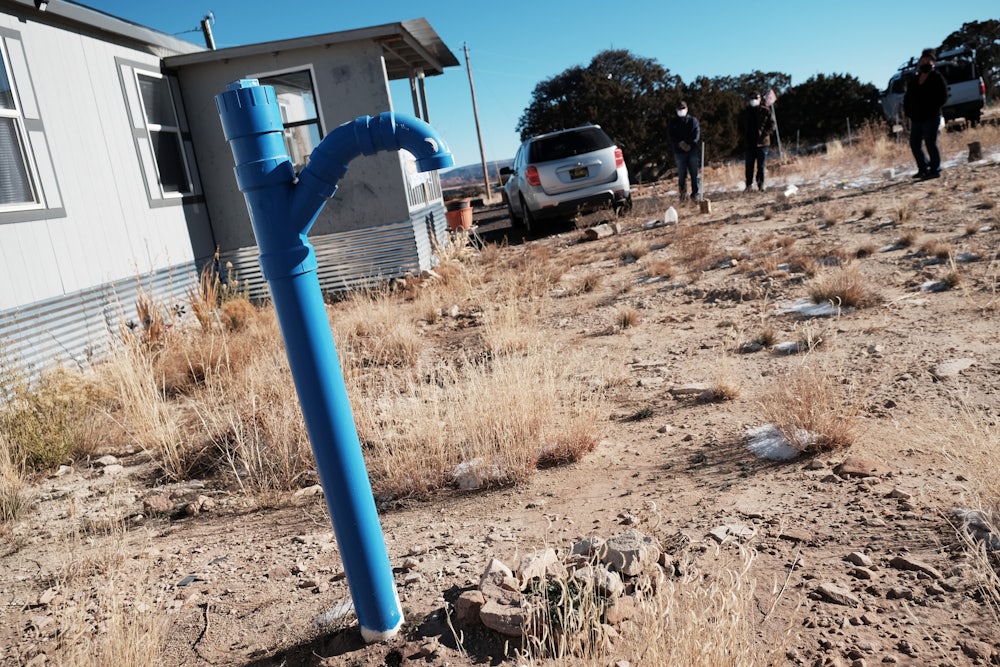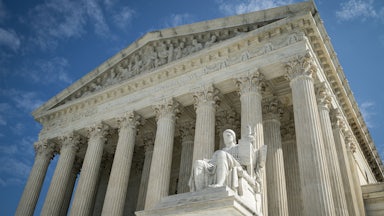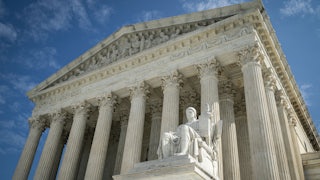The Supreme Court is extremely strict about what can be brought into its chambers during oral arguments. In addition to obvious items like guns and knives, visitors must leave just about every other personal item outside when they enter. Cameras, cell phones, laptops, and the like are left outside—even if you’re a reporter. No snacks or drinks can be brought in. Not even water.
On March 20, however, the entire Colorado River will be looming over the justices when they hear oral arguments in Arizona v. Navajo Nation. The case, which dwells at the intersection of Native treaty rights and water rights, will mark the court’s latest foray into the byzantine rules and regulations that govern limited supplies of water in one of the driest parts of the country. For the Navajo Nation, the court’s decision on its nineteenth-century treaty rights could have serious consequences for its future.
One half of the case’s origins involves the treaty rights promised to the Navajo Nation when it agreed to reside on the reservation in the late nineteenth century. In 1848, the federal government signed its first treaty with the Navajo people where it promised to delineate a permanent reservation for them within their historical homelands and legislate to secure their “permanent prosperity and happiness.” That, tragically, did not come to pass.
Instead, United States troops forcibly relocated the majority of Navajo men, women, and children from Arizona to eastern New Mexico in a brutal and violent military campaign in the mid-1860s. In 1868, the remaining leaders began negotiations with General William Sherman, who acted on behalf of the U.S., to end the deadly imprisonment. Central to the negotiations, the Navajo Nation told the court, was a mutual desire by both sides to supply the Navajo with arable land where they could farm and ranch. Access to water was a necessary precondition to those hopes.
“The result was the 1868 Treaty, which established the Navajo Reservation and promised opportunities and tools for farming and funds for thousands of animals to replenish the Navajo herds,” the tribe said in its brief for the court. “The Treaty, in short, promised both land and water sufficient for the Navajos to return to a permanent home in their ancestral territory.” Over time, the initial land grant grew to encompass a significant portion of what is now northeastern Arizona, making it the largest Native American reservation in the United States.
In the Navajo Nation’s eyes, the U.S. has not yet lived up to its promises to help the tribe become self-sufficient. It told the court that 30 percent of its members don’t have access to running water, forcing them to seek it from distant nonpotable sources at considerable cost and effort. “While the average American uses 80–100 gallons of water per day for household needs, Navajo Nation members use about seven,” the tribe noted. “The resulting difficulty in maintaining hand hygiene contributed to a Covid-19 death rate higher in the Nation than in many other parts of the United States. And droughts have only made things worse.”
The other half of the case’s history springs from a century of broader legal squabbles over water rights for the Colorado River, the most important waterway in the southwestern U.S. Seven states formed an interstate compact in 1922 to settle the division of rights. The Colorado River Compact effectively divided the river and its waters into two portions, with Colorado, New Mexico, Utah, and Wyoming forming the upper half and Arizona, California, and Nevada forming the lower. It did not resolve, however, how much water should be allocated among the states within each half. Arizona and California went to the Supreme Court in 1952 over the question, drawing other states and the federal government into the dispute.
Lawsuits between the states themselves fall under the high court’s original jurisdiction, meaning no lower court hears the case. Arizona v. California and its related cases are among the most complicated disputes in the court’s history, and it serves no purpose to summarize them at any great length here. What matters in this particular case is that the U.S. intervened on behalf of five Southwestern tribes in the Lower Colorado River basin to provide them with adequate access to water, which the court granted.
The Navajo Nation was not among those five tribes. Instead, the federal government asserted a claim on their behalf for water rights from the Little Colorado River, a tributary of the main waterway, over the tribe’s objection at the time. The Supreme Court did not address those specific claims in its labyrinthine decision and largely focused on the more immediate disputes between the various states. But the justices took care to note that the decree did not affect “the rights or priorities, except as specific provision is made herein, of any Indian Reservation.”
In 2003, the Navajo Nation sued the federal government on multiple grounds, including a breach-of-trust claim. That claim sprang from the government’s failure to properly secure the reservation’s water rights despite the treaty promises made in 1968. “This case is about this promise of water to [this] tribe under [these] treaties, signed after [these] particular negotiations reflecting this tribe’s understanding,” the tribe told the court. “A promise is a promise. And a promise in a treaty, the U.S. concedes [in its own brief for the court], is binding.”
The Ninth Circuit Court of Appeals agreed and, after nearly a decade of litigation, ruled in favor of the Navajo Nation in 2021. “The Treaty’s farming-related provisions, which sought to encourage the Nation’s transition to an agrarian lifestyle, would have been meaningless unless the Nation had sufficient access to water,” the three-judge panel noted in its opinion. Indeed, as the court noted, it would have been virtually impossible for Navajo farmers to grow crops in the arid Southwest without ready access to irrigation. The court rejected the Interior Department’s claim that no such promise existed and that the Ninth Circuit’s ruling would interfere with the Arizona v. California litigation that had parceled out the Colorado River’s existing water rights.
The Justice Department asked the Supreme Court to intervene. In its brief, it argued that the federal government has no duty to secure water rights for the Navajo Nation from the mainstream of the Lower Colorado River. It also disputed that the treaties bound the U.S. by any specific obligations to act. “The [Ninth Circuit] relied on provisions in the 1868 Treaty relating to farming on the original Navajo Reservation, but those provisions did not impose any duty on the United States relating to water—let alone any duty resembling the duty that the Navajo Nation asserts here,” the department claimed.
The tribe strongly disagreed. It noted that treaty promises are typically read by courts in the context in which the treaty signers, including the Navajo leaders, would have understood them. “The United States, for its part, recognized the unsuitable living conditions at Bosque Redondo and acceded to the Navajos’ request to return to their homeland,” the Navajo Nation explained to the court. “When it signed the 1868 Treaty, the United States knew that water access was crucial to the survival of Indians living in the Colorado River Basin.”
Since it could have implications for water rights allocations of other jurisdictions along the Colorado River, a coalition of states intervened on the federal government’s side to argue against the Navajo claim. They insisted that the Ninth Circuit and other lower courts had erred by departing from the framework established in the Arizona v. California litigation and other agreements, which are collectively known as the Law of the River for clarity’s sake.
To that end, the coalition of states urged the Supreme Court to reject the claim on practical and procedural grounds. “Having different courts dividing (or re-dividing) a limited resource invites chaos, as neither users nor system operators will have the certainty that a water adjudication is supposed to provide to attract the investments needed to reclaim desert lands for irrigation and to develop and maintain an urban civilization,” the states argued.
The Navajo Nation countered, however, that the states’ intervention is premature at best because the 1868 treaty guaranteed water rights without specifying the Colorado River as the source. “If the suit succeeds and the government ultimately determines that it may need Colorado River water to fulfill its promise, then the parties might need to return to this Court,” the tribe argued. “But the Nation’s claim does not depend on rights to Colorado River water. It thus does not fall within the narrow category of issues implicating this Court’s retained original jurisdiction.”
In making its argument to the court, the Navajo Nation also took pains to note that the court need not issue a ruling that could alter water rights claims beyond the Colorado River. “Requiring the United States to fulfill its specific treaty promise to provide the Nation with adequate water goes no further than interpreting these treaties with this tribe in this case,” the Navajo Nation told the court. “As this Court has recognized, different treaties with different tribes, even with similar language, may mean different things in light of the negotiations and historical context.”
At the same time, a ruling against the tribe could have implications for water rights cases involving tribes outside the region. A coalition of prominent tribes filed a friend-of-the-court brief in favor of the Navajo Nation, where they urged the justices to abide by the principles the court previously laid out in the 1908 case Winters v. United States. That case established that the U.S. holds an implied trustee relationship over water rights for tribal reservations, since those reservations could not logically exist or prosper without access to water.
The tribes urged the justices to uphold the Ninth Circuit’s ruling and help enforce a trust that many tribes understood to exist when they signed treaties with the U.S. in the nineteenth century. If the court does not act, they noted, tribes could face even greater hurdles in protecting their water rights from encroachment by other parties. “A trustee that does not even know the scope of the property with which it has been entrusted to preserve and manage, or take the necessary steps to figure it out, is no trustee at all,” they noted.
The Supreme Court’s track record on tribal rights cases in recent years is somewhat mixed, as I’ve previously noted. In a series of cases about the continued existence of reservations in Oklahoma, the court first recognized that more than half of the state was Indian country in 2020, then sharply curtailed tribal sovereignty in a follow-up case two years later. Oral arguments in Arizona v. Navajo Nation will give further insight into whether the latter ruling was an isolated precedent, or if the court is more broadly unwilling to hold the U.S. to the promises it made more than a century ago.










